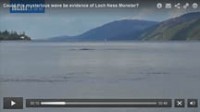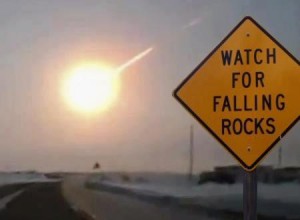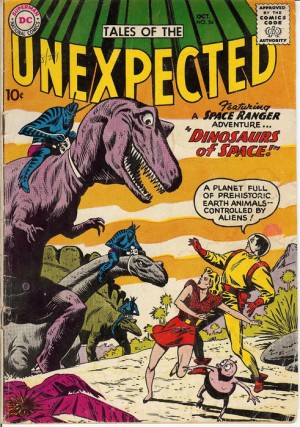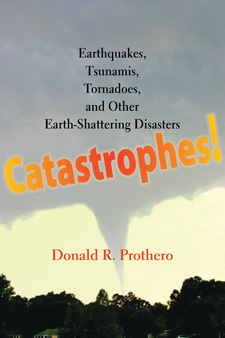by
Donald Prothero, May 21 2014
As I wind down the semester teaching six different classes in introductory geology and oceanography at three different colleges, I’ve found myself explaining in nearly every lecture the difference between the real world and the popular mythology that appears in the movies, television, and the cartoons. Since nearly everything the general public thinks they know about science seems to come from bad Hollywood movies and TV shows, it’s not surprising that these myths are perpetuated, and our scientific literacy is so abysmal.
This is not a new topic, of course. Physicists and astronomers have long complained how badly most sci fi movies and TV and novels mangle science (starting with the impossibility of transmitting sound in the vacuum of space, which nearly all the space movies get wrong—but explosions without sound simply don’t do it for today’s audiences). I know of some geology departments that have “Bad geology movie” nights, where they play older films and laugh at all the ridiculous things they say about the earth. (In fact, nearly every Hollywood movie gets the geology all wrong). But I’ve been a scientist since I was hooked on dinosaurs at age 4, and consequently I’ve never enjoyed movies that distort or violate the rules of science. Websites like TVtropes.org document the wide range of stupid or silly things that show up regularly in movies or TV, and how little reality or science influences the decisions of scriptwriters. Of course, this is basic Scriptwriting 101: the story arc of the plot, the development and interaction of characters, and many other things take priority over keeping the movie within the bounds of scientific reality. I’ve been a scientific consultant on enough shows to know that what I say is only a guideline, and the story and characters take precedence over reality. Still, in many or most cases, the movie plot would work just fine with a realistic portrayal of science, but that rarely happens. After all, screen writers tend to be no more literate about science than their audiences, so to a large extent they don’t know that all these cliched ideas are false—and most don’t seem to care, even if it is explained to them. As TVtropes.org puts it, it’s the “Rule of Cool”: audiences will forgive gross scientific inaccuracies and completely implausible action if it makes the movie more spectacular and enjoyable. Continue reading…
comments (22)
by
Daniel Loxton, Oct 15 2013
This post was written at the beginning of September as a commission for a daily tabloid newspaper in the UK, which wanted a short response to a then-current “Loch Ness monster video” story that briefly made headlines around the world…for some reason. (I’m obligated to say, “That’s the real mystery!” although the timing was excellent for promoting a new book that collects Nessie and other mystery material from The Mirror archives.) By the time the rush piece was completed, the news cycle had moved on, and the piece was never run. I present it here essentially unaltered.

Click through to a Daily Mail story to watch Elder’s video footage
Much ink and many pixels have been spilled over a new [publicized late August, 2013] video notable for not showing any part of a Loch Ness monster. Everyone agrees that the video shot by East Kilbride photographer David Elder instead shows a wave. Nonetheless, as Elder told the Mirror, “I’m convinced this was caused by a solid black object under the water. The water was very still at the time and there were no ripples coming off the wave and no other activity on the water. … It is something I just can’t explain.”1
Seems weird; therefore, monster! Media rushed to craft headlines asking, could this unremarkable footage finally be “proof” of Nessie? (A useful rule of thumb warns that headlines ending with question marks should always be answered, “No.”)
Continue reading…
comments (6)
by
Donald Prothero, Apr 03 2013

The workshop was held at NESCent, with modern facilities built inside classic old brick buildings on the Duke campus that used to be warehouses
On the weekend of March 22-24, 2013, I was privileged to be part of an amazing workshop entitled “Reporting across the culture wars: engaging media on evolution.” Hosted by the NSF-sponsored think tank, the National Evolutionary Synthesis Center (NESCent) on the Duke University campus in Durham, North Carolina, it brought together some of the top names in both science and journalism, all experienced in the battle over evolution and creationism. It was organized and moderated by Lauri Lebo, the local reporter at the 2005 Dover, Pennsylvania, “Intelligent Design” trial who wrote a best-selling book, The Devil in Dover, about her experience, and by molecular biologist Dr. Norman Johnson of University of Massachusetts Amherst. These two organizers raised the funds to bring in a very diverse panel of experts, including Dr. Ken Miller of Brown University, one of the leading biologists battling creationism (he was the star of the Dover trial, and has beaten creationists in debates many times); Josh Rosenau of the National Center for Science Education (NCSE), who handles their efforts to support citizens fighting creationism in their schools; several authors of books about evolution and creationism, including yours truly, plus Dr. Michael Berkman of Penn State, Dr. David Long of George Mason University, and Dr. Daniel Fairbanks of Utah Valley University; a distinguished group of biologists, including Dr. T. Ryan Gregory of Guelph University, Dr. Melissa Wilson Sayres of UC Berkeley, Dr. Craig McLain of NESCent, and Dr. David Hillis of the Univ. Texas Austin; anthropologists, including Dr. Holly Dunsworth of Univ. Rhode Island, Dr. David Long, and Dr. Briana Pobiner of the Smithsonian; and paleontologists including myself and Brian Switek of the Laelaps blog on Smithsonian.com. Among the journalists were Greg Bowers of the Univ. Missouri Journalism school, Lou DuBose of the Washington Spectator, Kate Sheppard of Mother Jones, as well as e-journalists such as Cara Santa Maria, the science editor of The Huffington Post (her regular podcast, “Talk Nerdy to Me”, is a big hit on HuffPo), and Danielle Lee and Bora Zivkovic of the Scientific American blog. In addition, there were local Public Information Officers (PIOs), who handle press relations for scientists, including Dr. Robin Smith of NESCent and Karl Bates of Duke University. In short, this panel brought both a lot of experience and a lot of brainpower to the discussion, with a panel ranging from freelance print journalists to e-journalists to science writers to distinguished scientists in biology, anthropology, and paleontology—and nearly everyone on the panel has their own blog.
Continue reading…
comments (7)
by
Donald Prothero, Feb 20 2013

Last Friday we all got a message from space. For weeks, scientists had been talking about the close pass of Asteroid 2012 DA14, and trying to use it as an opportunity to educate the public about the risk they might pose. Then, without any warning, a much smaller piece of rock zipped through the sky above Siberia and left lots of damaged windows and buildings—and a LOT of amazing footage from cameras of every kind (including lots of dash cams, which are the rage in Russia because of all the horrendously scary driving and insurance issues). Immediately, the media and internet was flooded with stories of every kind, from the merely uneducated (typically from mainstream media newspeople who know no science) to the positively weird. Count on an event like this, which grabbed the media’s fleeting attention worldwide for a precious day, to be the source of every bizarre notion you can imagine (and some you can’t).
First, some basics. It was apparent as news people all over the media mangled the terminology that most people don’t know one space object from another. Yet all of these objects in space have distinct names, and it’s not OK to interchange one with another. Thanks to the many crappy sci-fi movies about impacts threatening civilization and requiring Bruce Willis to save President Morgan Freeman and the rest of the world (never mind that none of them are remotely plausible scientifically), some of this misunderstanding is excusable. These mistakes are just symptomatic of the general scientific illiteracy of most people—sadly, even among news media people who should understand more of the facts behind the news they read than they actually do. (Cue the references to the hyper-smart newsman played by Jeff Daniels in the HBO series “The Newsroom”, who actually knows the facts behind most stories, and can conduct in-depth interviews without cue cards or teleprompters). Just so we’re all clear on these things, a helpful graphic is provided below the fold.
Continue reading…
comments (31)
by
Donald Prothero, Apr 25 2012

As someone who has frequently had his scientific research featured in the popular media, I’m painfully aware of the constant struggle between conveying science accurately and trying to make it sexy and newsworthy. Scientists are perpetually frustrated because reporters are often scientifically illiterate, and reduce the story to a level they can understand—which totally misrepresents what the science is about. The science reporters I know are equally frustrated at scientists who don’t know how to communicate the essence of what they are doing, or who are aloof and uninterested in making the public more aware of the reasons why their tax dollars should support pure scientific research. I’ve had my work oversimplified or misrepresented many times, and I’ve seen the work of others completely butchered by incompetent science reporters. I’ve also seen scientists who make outrageous claims and trust gullible science reporters to buy it, hook, line and sinker—and this happens FAR too often (see my April 4 post about the coverage of a ridiculous claim by an amateur that dinosaurs were aquatic, or my Nov.2 post about gigantic Triassic squids arranging ichthyosaur bones).
One of the problems both scientists and reporters face is how to make the research sound interesting to a lay public that knows almost nothing about science—and much of what the public thinks they know is wrong. Much of chemistry and physics is incomprehensible and uninteresting to people that never took a single class in high school on physics or chemistry, and even something more immediate like biology is full of subjects that are obscure to the lay audience. Geologists usually have it slightly better, since topics like earthquakes, volcanoes, landslides, climate change, etc., are easier to relate to.
We paleontologists usually have it even easier, because a few of us work on something immensely popular—dinosaurs—although I’m really a Cenozoic fossil mammal specialist and only rarely has my research ventured back to the Mesozoic. Just add dinosaurs and the research goes to the front page of most science news websites or The New York Times, or gets published in high-profile journals like Nature, Science, or PNAS. But when I make an important discovery on a group such as rhinos or peccaries or camels, I’m lucky to get it published in a third-tier journal, and I typically get no reporters calling at all. The Cretaceous-Tertiary extinctions that wiped out the non-avian dinosaurs generated huge interest when the asteroid impact theory first emerged in 1980, with thousands of papers published and dozens of books on the topic. But it’s only the third or fourth largest extinction in earth history. The great Permian extinction 250 m.y. ago, which wiped out 95% of species on earth, is lucky to get ANY press attention. Who cares about productid brachiopods, or fusulinids, or tabulate or rugose corals, among the many victims of this event? Continue reading…
comments (20)
by
Donald Prothero, Apr 04 2012

The long-discredited idea of sauropods snorkeling in deep water as illustrated in this old painting by Zdenek Burian. The biggest problem is that they couldn't breathe in water this deep with the pressure it puts on their lungs.
The story popped into my email box earlier this week and soon I had dozens of follow-up emails from the vertebrate paleontology listserver flooding my inbox. Once again, the media have shown their complete inability to get the science right and publicized another flashy story that was complete garbage. I already gave an example last fall (my Nov. 2 post) with Mark McMenamin’s ridiculous claim that a giant Triassic “kraken” rearranged the bones of ichthyosaurs to create art. (By the way, that claim has dropped out of sight, and I don’t ever expect to see it published). As soon as the furor of that media gaffe dies out, however, they commit an even bigger blunder.
This time it was an article in the British media, starting with a “journalist” Tom Feilden (previously caught plagiarizing dino stories) reporting for the Telegraph doing an interview that then got coverage on both BBC radio and TV and on their website. In the brief story, a “Professor” Brian J. Ford makes the claim that giant sauropod dinosaurs were aquatic, not land-dwelling creatures. Immediately, the first reaction that my paleontologist colleagues and I had was “Who the hell is ‘Prof. Brian J. Ford’?” and “Did he say this in 1900?” To us, the article was startling not because it has some new insight on sauropods—but because someone who clearly had no idea about the last century of sauropod research had managed to get all this publicity, and there was no evidence he had any credentials to be taken seriously!
Continue reading…
comments (20)
by
Steven Novella, Mar 16 2009
By now the trend is obvious and not much news. Traditional newspapers are losing readership and advertising. They are laying off staff, cutting costs, and consolidating news offices.
This has been a very bad thing for science journalism, which has always been a mixed bag even in the best of times. Now newspapers are letting go their specialty reporters, like science journalists, and handing over science news to general reporters. The result has been an overall decrease in the quality of science journalism.
The culprit is what you are reading right now – blogs and the internet in general. The public now is used to getting their news for free online. Online news is also more timely, more interactive, it’s hyperlinked to references – it’s a web of information. I dare say it’s a better, more useful, more timely, and more cost effective venue for information.
Continue reading…
comments (19)






